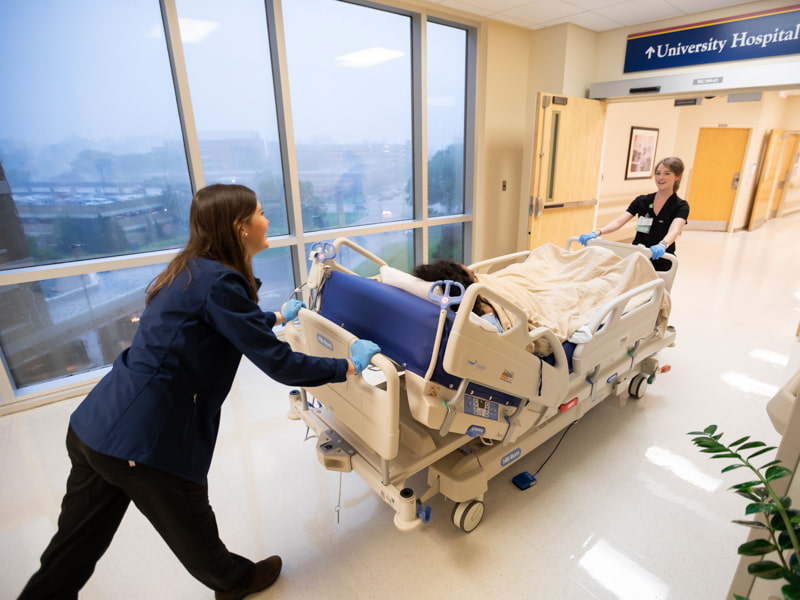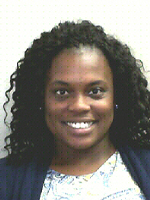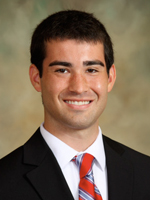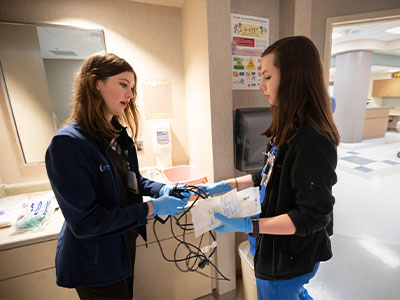100-Day Workout gives voice – and action – to employee suggestions

When the University of Mississippi Medical Center celebrates National Hospital Week each May, it's a time for the UMMC family to enjoy a corn dog from a food truck, relax with yoga and hula hooping, and perhaps savor a cookies and cream popsicle.
Problem is, some employees believe the festivities aren't for them because they don't physically do their jobs in one of the Medical Center hospitals.

In answer to employees’ concerns, National Hospital Week, May 12-18, will now be observed at UMMC as Employee Appreciation Week. The fun stuff stays the same, with one exception: the popular gurney races, previously a centerpiece of National Nurses Week, is now an activity of Employee Appreciation Week to make it inclusive of all employees. This year, National Nurses Week is May 6-12.
Being inclusive is just one opportunity for change recognized in UMMC’s 100-Day Workout, a nationally recognized quality improvement methodology that brings together multidisciplinary groups of employees to tackle performance, throughput, quality, safety, engagement and other issues.
Since 2016, the Medical Center has been assembling teams to take on the task of stretching their imaginations to hear the voices of employees and to effect change, whether that’s simply a tweak here and there, or a major overhaul. This year marks the first time teams were led and comprised with members of all mission areas – health care, academics and research – as well as service areas.

The workout has driven change management at UMMC, said Daniel Enger, operational improvement director. “More and more people are starting to be involved with the 100-Day Workout, and the plans will be sustainable and ongoing,” he said.
“UMMC has more of an action-oriented culture now, and the workout has done a great job of holding people accountable.”
Each workout addresses challenges and opportunities gleaned from UMMC’s Employee Engagement and Culture of Safety surveys. The confidential surveys are administered by Press Ganey, a national leader in improving patient and employee experience.
Due in part to the workout, “we’ve seen overall scores improve on questions pertaining to the six focus areas,” Enger said.
For the workout completed early this month, six focus areas received scrutiny: Employee Experience, led by Josh Clark, director of operations for clinical and translational research; Diversity and Respect, Dr. Hamed Benghuzzi, professor of clinical health sciences, and Robria Horton-Daniels, project manager in the School of Dentistry; Communication, Tom Fortner, chief Institutional Advancement officer, and Marc Rolph, Institutional Advancement executive director of communications;
Professional Development, Stephanie Lucas, director of research operations in Physiology and Biophysics; Going Above and Beyond, Angelina Knot, Department of Pathology business administrator; and Culture of Safety, Dr. Phyllis Bishop, chief quality officer.

“It was ironic that I ended up on the Employee Experience team for the 100 Day Workout,” Sims said. Making the shift to Employee Appreciation Week happened “through conversations with some of the team we were meeting with for the workout, as well as the team for Hospital Week,” she said.
A cross-section of front-line employees make up the teams. Teams checked in as a group at 30 days, 60 days and 90 days, with a summation of their progress due at the last meeting. Some made the decision to continue previous initiatives, while others came up with recommendations for new ones.
A sampling:
- Diversity and Respect
The team plans to continue two programs that have gained a foothold in the last year – Coffee Talk, which brings together a small group of employees to chat with a senior leader once a month; and Word of the Month, distribution of posters bearing a meaningful, positive word across campus to be a visual reminder of UMMC’s standards for a respectful and inclusive environment.
- Going Above and Beyond
The team will recognize work areas that achieved a “highly engaged” score on the 2018 Employment Engagement Survey by posting group pictures on UMMC’s “People of the U” Facebook page, campus monitors and the UMMC Intranet scroll.
- Culture of Safety
In conjunction with UMMC’s Performance Improvement staff, the team will work to standardize the way nurses hand off patients between units, during shift changes, and at any other time a patient’s care transitions from one nurse to another. The goal is to reduce serious patient harm errors caused by communication missteps during handoffs, said Brittany Ransom, nurse manager on 2 West.
The team also scrutinized data on the safety concern of employee slips, trips and falls, finding that cell phone use is the leading cause of distractions causing workers to take a tumble. Team members developed a “Defeat Distractions” awareness campaign.
- Employee Experience
The team created an all-new “Did ‘U’ Know” campaign to be broadcast campus-wide via hallway monitors, email and the intranet in conjunction with the Office of Well-being. It will celebrate employee accomplishments, inform employees about work perks and benefits, and highlight events and initiatives taking place in the UMMC community.
And, the team recognized the need employees with limited time for lunch breaks have for increased access to dining options. Recommendations under discussion include building a multi-use pavilion in the green space in front of the Credit Union; increasing outdoor picnic seating; extending coffee shop hours; employee-only “badge swipe” checkout lanes in the cafeteria; and on-campus food delivery for clinical staff.
- Professional Development
The team is working with the DIS Technology Learning Center to advertise across campus specific professional development class offerings and to increase both self-directed and manager-directed professional development activities. New managers are being instructed on how to book a TLC class in their work location and how to use the class offerings as a professional development tool in the employee evaluation process.
- Communication
The team is working with Health System leadership to create more robust and pertinent presentation of information at monthly leadership meetings attended by a cross-section of managers, supervisors and executives. Recommendations include encouraging a 15-minute question-and-answer period to invite difficult questions so that a culture of candor and trust can be developed.
The team also suggests that during the monthly meeting’s financial presentation, more time be spent on hot-button issues such as patient length of stay, patient acuity or commodity costs, with specific examples of success stories, best practices or lessons learned the hard way. The “story” of the numbers should be part of the presentation.
“Defeat Distractions” already is in full swing, with notices on video boards in University Hospital. Data collected by the Culture of Safety team show that between 2015 and 2018, UMMC paid an average $329,551 per year for employee falls, with an average 98 falls annually.
“It resonated with everyone,” said Barb Inman, a process engineer in Performance Improvement and the team’s coach.
“We thought a campaign would make people more aware that if you are on your cell phone, you’re usually focused on that, and not where you are going. People do get hurt.”


